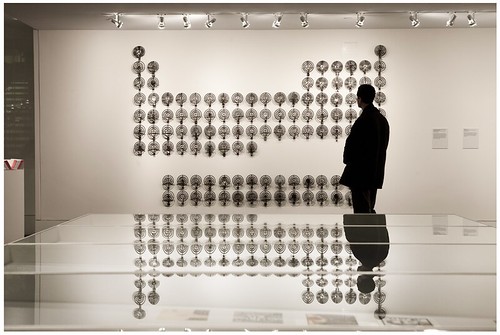
In celebration of the International Year of Chemistry, artists combine art with the periodic elements.
A chemical connection intertwined with art encompasses Elemental Matters: Artists Imagine Chemistry, an exhibit at the Chemical Heritage Foundation. It brings new perspective to how elements that comprise humans are viewed.
Dove Bradshaw of New York, has work displayed in the exhibit that displays this relationship.
“I had this idea much earlier, the idea of the body, when I was a child, wondering what we were made of,” Bradshaw said. “I always thought I was going to be an artist from the age of 5, but I didn’t think of this idea as an artist idea. I was just wondering, questioning, thinking, imagining what it would look like if there were heaps of this part of us and heaps of that part of us.”
Bradshaw’s childhood curiosity takes shape in her contributions to the exhibit. “Song of Which” is an ephemeral, black-and-white portrait of a naked woman behind a veil listing the elements found in the human body. The size of each word is proportionate to the amount of the respective element in the human body.
Christy Schneider, coordinator of exhibitions, and Majorie Gapp, curator of art and images, both CHF staff members, were part of planning the project, which celebrates the International Year of Chemistry in 2011.
Schneider said that the concept of art at a chemistry museum isn’t so new.
“Art on the subject of science has been a popular topic for many years,” Schneider said. “This exhibit may be an extension of what we normally do, which aims to broaden the knowledge and appreciation of both the history and applications of chemistry.”
The works in the exhibit each hold their own “eureka” moment, allowing the viewer to see the elements and the periodic table from a new angle. David Clark’s “Braille” is two eye charts of the elemental abbreviations, one in print and the other in braille. Clark also contributed a piece of 118 stove coils in the shape of the periodic table.
The nucleus of the exhibit is the Periodic Table Printmaking Project, conceived by Jennifer Schmitt of Concord, Mass.
One-hundred-and-eighteen prints by 97 artists illustrate every element. Uranium is depicted as a nuclear explosion at first glance, but a vase of flowers is revealed upon a second look. Beryllium is drawn alongside grapes, and Neon is fashioned as a recognizable glowing sign.
“There are numerous artists exploring the composition of the material world in very interesting ways,” Schneider said. “We extended invitations to those artists whose work had very strong connections to the subject.”
For Bradshaw, the gap between art and science is minuscule, if existent at all.
“I don’t see them as a contradiction to begin with,” Bradshaw said. “I think scientists use intuition to come to their concepts or theories, and to prove them they have to make leaps–it’s just expressed in a different way.”
Bradshaw also contributed a piece that consists of water slowly dripping on limestone, creating a hollow in the cube. Upon hearing a comment that watching the piece is like meditating, Bradshaw was flattered.
“I do meditate myself,” she said.
Bradshaw said she was “particularly struck” by a fellow artist’s, Susan Alexjander’s, contributions to the exhibit.
Alexjander converted atomic level frequencies from the light spectrum to a hertz number, then lowered the octaves until they reached a frequency that could be heard by the human ear. She then programmed the conjured noises into a synthesizer, creating music from chemistry. Alexjander’s music plays throughout the exhibit, creating a multi-sensory experience for attendees.
“We expect and plan for a very diverse audience,” Schneider said. “Our exhibit and programs will be of interest to the art world, history aficionados, as well as people involved in the sciences.”
Elemental Matters: Artists Imagine Chemistry will be on display at the Chemical Heritage Foundation at 315 Chestnut St. from 10 a.m. – 4 p.m. until Dec. 16.
Jenelle Janci can be reached at jenelle.janci@temple.edu.



Wonderful to see the periodic table getting so much attention these days!
for more info and resources on the periodic table please see,
ericscerri.com/